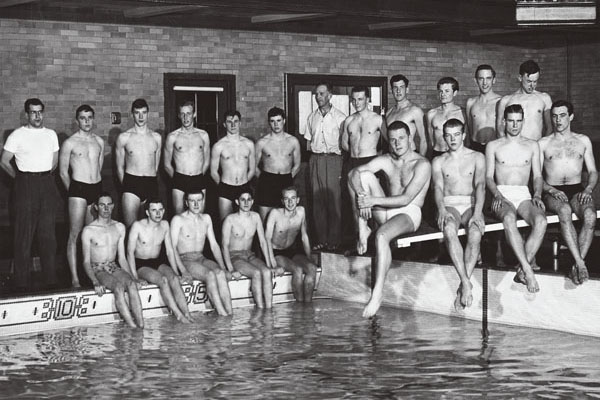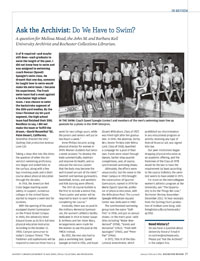In Review
 IN THE SWIM: Coach Speed Speegle (center) and members of the men’s swimming team line up poolside for a photo in the 1949 Interpres. (Photo: University Libraries/Department of Rare Books, Special Collections, and Preservation)
IN THE SWIM: Coach Speed Speegle (center) and members of the men’s swimming team line up poolside for a photo in the 1949 Interpres. (Photo: University Libraries/Department of Rare Books, Special Collections, and Preservation)U of R required—and maybe still does—each graduate to swim the length of the pool. I did not know how to swim and was assigned to swimming coach Roman (Speed) Speegle’s swim class. He dreamt that one day, someone he taught how to swim would make his swim team. I became his experiment. The frosh swim team had a meet against a Rochester high school team. I was chosen to swim the backstroke segment of the 200-yard medley. By the time I finished my 50-yard segment, the high school team had finished their 200. Needless to say, I did not make the team or fulfill the dream.—David Rosenthal ’52, Palm Desert, California.
Rosenthal directed the 1952 Quilting Club production Andean Love Call.
Taking a deep dive into this letter, the question of when the University’s swimming proficiency test began and ended bobs to the surface, along with a few laps involving pools and a short course about physical education through the decades.
In 1914, the American Red Cross began teaching water safety; in support, numerous colleges in the United States started to require a swim test for students.
With the opening of the pool-equipped Alumni Gymnasium on the Prince Street Campus in 1900, the University hired Edward Green as its first full-time physical education instructor. According to the October 17, 1900, Campus (precursor to today’s Campus Times): “The freshmen and sophomores will be required to exercise three hours a week for two college years, while the juniors and seniors will put in two hours a week.”
Irene Phillips became acting physical director for women in 1909. Women students had twice-a-week sessions “to develop the body symmetrically, maintain and improve its health, and so educate the nervous system that the body may become the well-trained servant of the mind.” Swedish and German gymnastics, basketball, tennis, and aesthetic and folk dancing were offered.
The 1917–18 course bulletin is the first to include a notice that, “Every junior and senior will be required to learn to swim before completing her course.”
Ironically, there was no pool in the Anthony Memorial Gymnasium, the women’s athletics facility dedicated in 1914 to honor Susan B. Anthony and her sister Mary. Arrangements were made for the women to use the pool at the YWCA instead.
By 1922, the men also had to pass a swimming test. Speed Speegle arrived in 1926, and Hazel (Gram) Wilbraham, Class of 1927, was hired right after her graduation. In 1945, the alumnae, led by Mrs. Dexter Perkins (née Wilma Lord, Class of 1918), launched a campaign for a pool of their own. Funds were raised through dances, barber shop quartet competitions, and, of course, synchronized swimming shows.
Ultimately, the efforts were unsuccessful, but the move to the River Campus in 1955 brought the construction of Spurrier Gymnasium, named in 1974 for Merle (Spurt) Spurrier, professor of physical education, with the Wilbraham Pool. The current Speegle-Wilbraham Aquatic Center was dedicated in 1982.
The synchronized swimming group took the name “Doll-Fins” in 1958, and put on annual shows—in the men’s pool—with titles including “Water Wonderland” (1958), “Scents and Nonsense” (1963), “Pooh with Apologies” (1965), and “Peter Pan” (1966).
In 1972, Title IX of the Educational Amendment, which prohibited sex discrimination in any educational program or activity receiving any type of federal financial aid, was signed into law.
Our peer institutions began dropping physical education as an academic offering, and the freshmen of the Class of 1978 would be the last to have the requirement (at least according to the course bulletin); the swim test seems to have ended in 1971.
For more on the intercollegiate women’s athletics program at the University, see “The Opportunity to Do the Things We Love,” Rochester Review, November–December 2012. To hear excerpts from the Quilting Club’s production of Andean Love Song, visit: livinghistory.lib.rochester.edu/qc1952.
Need History?
Do you have a question about University history? Email it to rochrev@rochester.edu. Please put “Ask the Archivist” in the subject line.

